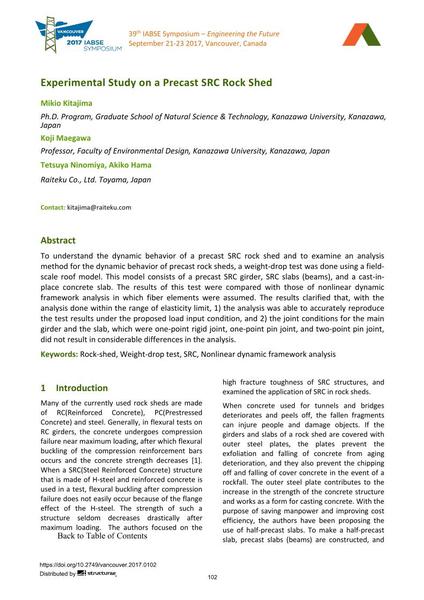Experimental Study on a Precast SRC Rock Shed

|
|
|||||||||||
Bibliografische Angaben
| Autor(en): |
Mikio Kitajima
(Ph.D. Program, Graduate School of Natural Science & Technology, Kanazawa University, Kanazawa, Japan)
Koji Maegawa (Professor, Faculty of Environmental Design, Kanazawa University, Kanazawa, Japan) Tetsuya Ninomiya (Raiteku Co., Ltd. Toyama, Japan) Akiko Hama (Raiteku Co., Ltd. Toyama, Japan) |
||||
|---|---|---|---|---|---|
| Medium: | Tagungsbeitrag | ||||
| Sprache(n): | Englisch | ||||
| Tagung: | IABSE Symposium: Engineering the Future, Vancouver, Canada, 21-23 September 2017 | ||||
| Veröffentlicht in: | IABSE Symposium Vancouver 2017 | ||||
|
|||||
| Seite(n): | 102-109 | ||||
| Anzahl der Seiten (im PDF): | 8 | ||||
| Jahr: | 2017 | ||||
| DOI: | 10.2749/vancouver.2017.0102 | ||||
| Abstrakt: |
To understand the dynamic behavior of a precast SRC rock shed and to examine an analysis method for the dynamic behavior of precast rock sheds, a weight-drop test was done using a field- scale roof model. This model consists of a precast SRC girder, SRC slabs (beams), and a cast-in- place concrete slab. The results of this test were compared with those of nonlinear dynamic framework analysis in which fiber elements were assumed. The results clarified that, with the analysis done within the range of elasticity limit, 1) the analysis was able to accurately reproduce the test results under the proposed load input condition, and 2) the joint conditions for the main girder and the slab, which were one-point rigid joint, one-point pin joint, and two-point pin joint, did not result in considerable differences in the analysis. |
||||
